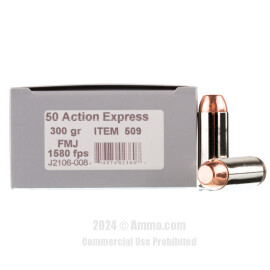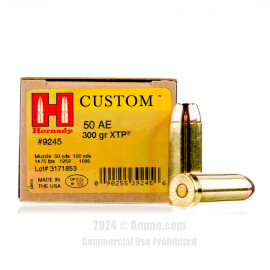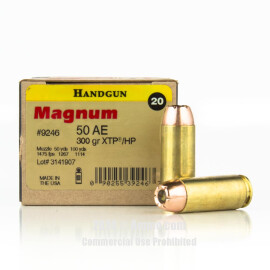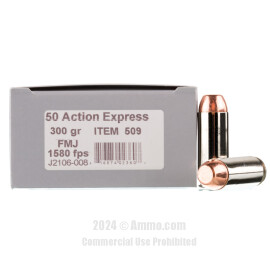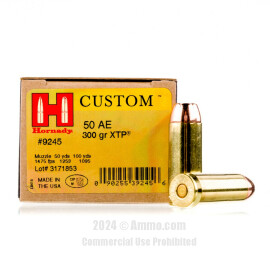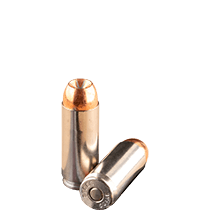
50 Action Express Ammo For Sale
History of 50 Action Express Ammo
The .50 Action Express cartridge is, without a doubt, one of the world’s most powerful pistol cartridges. It features a .500-inch bullet diameter (33mm) in a 1.285-inch straight-walled case that has a rebated rim. The overall length of the standard .50 AE round measures 1.610 inches, and the ammo is powered with a large pistol primer. According to the Sporting Arms and Ammunition Manufacturers’ Institute (SAAMI), the maximum pressure of .50 AE ammo should not exceed 36,000 pounds per square inch (psi).
Combining the bullet size with the ammunition’s velocity and muzzle energy, it’s not hard to imagine that with the .50 Action Express, there’s a lot of force coming from the end of a handgun. While the .50 caliber ammo does have a significant recoil and muzzle blast, the firearms chambered to the caliber offer a heavy weight and a slide that absorbs much of the action. Because of this, many compare the perceived recoil as about equivalent to the .44 Magnum.Development of the .50 Action Express Ammo
The .50 Action Express was developed in by Evan Whildin in 1988, then vice president of Action Arms, Ltd., with the goal of pushing the performance of a semi-automatic pistol far beyond the limits that it had so far reached – and, it should be said, he was remarkably successful in his endeavors.
Whildin created the Action Express line to fire hotter and travel faster than the standard forms of ammunition. When he was satisfied with his product, he released the ammunition in more than just the .50 AE, he also had Action Express in 9mm and .41 caliber. These smaller ammunitions never caught on with the shooting public, and today only the .50 Action Express is available.
One of the reasons for the .50 AE’s popularity is because of the ammunition’s amazing performance. The .50 AE launches a 325 grain Hornady bullet at 1,400 feet per second (fps) out of a six-inch barrel with a muzzle energy that exceeds 1,400 foot pound force (ft·lb). If that's not impressive enough, at 100 yards, the bullet’s still traveling at 1,138 fps and carrying 930 ft·lb of energy. Those performance standards mean the .50 AE ammo round, at 100 yards, has more than double the energy of a standard .45 ACP round at the muzzle, pretty impressive for a bullet that’s half an inch wide.
Although the .50 AE design was intended for the Israeli Military Industries (IMI) Magnum Research Desert Eagle, the first gun actually chambered to the .50 AE caliber was the Arcadia Machine and Tool (AMT) Automag V – a semi-automatic, single action pistol that’s been called the most “ergonomic and lightweight” of the big caliber handguns.
Due to the power behind the .50 AE, the Automag V had built-in recoil compensator ports in its barrel and, like other AMT pistols, is made of stainless steel. The magazine holds five rounds, making the handgun 5+1. Although the gun was relatively manageable, given the power of the ammunition, less than 3,000 were manufactured.
In its original form, guns chambered to the .50 AE featured a bore diameter of .510 inch, which makes sense to effectively handle the half-inch bullet. But the ammo ran into trouble because, according to United States law, non-sporting firearms can’t have a bore diameter larger than .5 inch.
Not to be discouraged, Whildin tapered the ammo’s shell and, instead of using traditional rifling methods, a polygonal rifling was attempted and accepted. This is the rifling currently seen in the .50 caliber Desert Eagle. It allowed the firearm to pass within Title 1 classification, giving the general public the ability to shoot this powerful cartridge.
Types of .50 AE Ammo
The .50 AE is available in many bullet types, including jacketed hollow point (JHP) and soft point (SP).
JHP ammunition features a lead bullet jacketed in a harder metal, typically copper. Within the round bullet, a hollow point is made, which allows the projectile to better expand upon impact. JHP ammunition is used in home defense, personal protection, and hunting rounds.
With a little less stopping power than JHP, soft point ammo offers shooters a slower expansion and deeper penetration than other bullets. Made with a soft lead projectile, soft point .50 caliber cartridges can still take down big game and are often used in areas that restrict JHP bullets.
Multiple ammunition companies manufacture .50 AE ammo – including CCI, Speer, Hornady, and IMI, which is imported by Magnum Research.
Hunting with the .50 AE
Because the .50 AE is such a capable ammunition and the firearms chambered to the cartridge tend to be hefty and accurate, the combination performs exceptionally well when it comes to hunting. With the power and speed of the bullet, the .50 AE can handle any game animal in North America. What’s more, it can also handle the apex predators that are often on the same hunting grounds, giving hunters an effective backup whether they’re hunting with a rifle or a wheelgun.
Even though the .50 AE is not as popular a choice as other cartridges, it is more than adequate and is often used for defense against bears and as a backup handgun for those who live, hunt, and fish in dangerous game territory.Other Uses for the .50 AE
In addition to hunting and protection against predators, shooters use the .50 Action Express for metallic silhouette shooting, as the bullet travels hard, fast, and long.
Because of the massive size of the handguns chambered in .50 caliber, they are too big for any type of carry concealed weapon. While they can be used for home protection, the shooter should be sure to practice regularly as the return to target time is slower than with smaller, more compact self-defense rounds, making rapid refire difficult, if not impossible.The Desert Eagle
The Magnum Research Desert Eagle handgun is, by far, the most common platform for the .50 AE. In its standard six-inch barrel, the Desert Eagle fires a Speer 300 gr bullet at a velocity of 1,500 fps and with a muzzle energy of 1,500 ft·lb force. Up the firearm to a 10-inch barrel, and that same bullet travels at an astounding 1,600 fps and with 1,800 ft·lb muzzle energy.
Beyond this amazing power and performance, the Desert Eagle has many unique features not seen in traditional semi-automatics. For instance, the pistol is gas operated, not recoil operated. This means that it’s actually gas that operates the slide mechanism, not the recoil from the explosion.
The firearm’s construction consists of a complex and machined arrangement, especially with its fixed barrel and rotating bolts, nothing like the simple one-touch breakdowns some handgun enthusiasts are used to. But that makes the firearm solid and secure, and each time it fires, there’s a consistency and regularity, regardless of the ammunition.
For distance shooters, the Desert Eagle comes standard with a machined top rail, perfect for installing optics. Just be sure the optical can withstand the recoil, as it’d be a loss to see one broke after just a round or two of plinking.
While not the most versatile pistol in the world, the Mark XIX Desert Eagle chambered to the .50 AE does offer some options, as shooters can easily convert the firearm to a .44 Remington Mag with a simple barrel and magazine change.
When it comes to how the pistol handles, Desert Eagle .50 caliber ammo is powerful, effective, and accurate. It’s not a one-handed gun, even for the biggest of big bore fans. If the recoil is too much in the six-inch barrel, opt for the 10 inch, as the added weight dampens the perception of the muzzle blast and recoil, making it a little easier to handle. If making the switch to the longer piece, have a good grip, as the balance of the six-inch barrel is noticeably better.
Sure the Desert Eagle has massive power and versatility, but it also has its downfalls. The firearm is too big to conceal and too heavy to carry on a routine basis. It has too much weight for a sidearm and can’t be worn on a belt. Even in its case from the manufacturer, the gun has to be disassembled to fit.
Without extensive and regular training with the Desert Eagle, its next to impossible to engage in rapid refire. What’s more, cheap .50 AE ammo is hard to find (although .50 AE ammo bulk sales can offer some discounts), making regular practice an expensive hobby. Yet, even with all those cons, it is one of, if not THE, most powerful semi-automatic handguns in the world, making it well worth the sacrifice to experience.
In addition to the Desert Eagle and the Automag V, the LAR Grizzly Win Mag was also chambered to the .50 AE.
Different Names for the .50 Action Express
Like many other ammunition sizes, the .50 AE is often called by and referred to by different names. Shooters may encounter such names as:
- .50 Action Express
- .50 AE
- .50 caliber
- .50 cal
- 12.7x33mm
Sometimes, shooters can also encounter the ammunition labeled as 50 Action Express or 50 AE, without the dot in front of the number. Although the meaning is conveyed in the right manner, obvious that it’s a .50 caliber reference, writing the ammunition name this way is incorrect.
The number, along with the decimal that accompanies it, isn’t just the ammo’s name, but is the actual dimension of the projectile’s diameter. That means the decimal point is not arbitrary, and needs to be included when writing the caliber..50 AE vs. .44 Remington Mag
Let’s take a look at a comparison between the .50 AE and the .44 Remington Magnum. While the .454 Casull may be the cream of the crop when handgun hunting with revolvers, many agree the .44 Rem Mag is more of the sweet-spot caliber – as it still has significant power, but without the hard-to-manage recoil.
When put side by side, the .50 AE and the .44 Rem Mag don’t look much different. They both have a case length of 1.285 inches and an overall length of 1.61 inches. Both ammunitions feature a large pistol primer and have a set maximum pressure of 36,000 psi. But that’s where the similarities end.
The bullet diameters of these two calibers differ by .071 inch, which makes more difference than one would think. In performance, the .50 AE tops the .44 Mag in every aspect. When comparing 300 gr bullets, the .44 Mag achieves 1,250 fps with a muzzle energy of 1,041 ft·lb force. The same weight bullet in .50 AE reaches a velocity of 1,500 fps with a 1,500 ft·lb force, significantly more power and blast.
While these performance stats make the .50 AE much more deadly, some would argue that the .44 Mag is easier to handle – and in some cases this may be true. After all, the 300 gr bullet mentioned above is a heavy projectile for the .44 Mag, which has a standard size of around 240 gr. Yet because of the overall size and stability of the firearms chambered to the larger caliber, many shooters say that the difference in perceived recoil and blast between the two cartridges is minimal.
FAQ
What does .50 AE stand for?
The .50 AE stands for the .50 caliber Action Express. It is one of the world’s most powerful handgun ammunitions. The ammo holds a one-half inch diameter bullet.
Who made the .50 AE?
The .50 AE was developed by Evan Whildin in 1988. At that point in time, he was the vice president of Action Arms. His goal for the Action Express was to push the limits that had been set for semi-automatic pistols.
What guns are chambered in the .50 AE caliber?
The most common gun chambered in .50 AE is the Magnum Research Desert Eagle, which is also available in .44 Mag. Shooters can also find other .50 AE chambered firearms, including the Automag V and the Grizzly Win Mag.
What causes more damage, a .308 Winchester or a 50 AE?
When comparing the .308 Winchester to .50 AE, the Winchester is significantly more powerful. A rifle cartridge, the .308 is loaded to nearly double the pressure (62,000 psi compared to 36,000 psi for the 50 AE) and reaches a velocity about double the pistol cartridge. The muzzle energy is also significantly higher, with over 1,000 more foot pound force.
Which is more powerful a 44 Magnum or 50 AE?
When comparing the .44 Magnum and the .50 AE, the Action Express is significantly more powerful, with a higher velocity and foot pound force.
What is the difference between the .50 AE and the .50 Beowulf?
The .50 AE is a semi-automatic pistol cartridge, while the .50 Beowulf is a rifle cartridge for use in a modified AR-15. The Beowulf uses the Action Express as a parent case, but lengths it nearly one-half inch and replaces the large pistol primer with a large pistol magnum. These changes result in more energy, velocity, and power in the Beowulf.
50 Action Express Ballistics: Chart of Average 50 Action Express Ballistics
The choice of the .50 AE is a great one for the person who wants to shoot a unique, large bore handgun cartridge that kicks like a mule. It also makes a good sidearm for anyone in the backcountry who needs the ultimate defense against dangerous animals. And while it may not be the easiest of ammunitions to fire, there’s something to be said about having that much power in one’s hands. When paired with a champion firearm, such as the Desert Eagle, shooting the .50 Action Express is something most shooters won’t forget.
Note: This information comes from the manufacturer and is for informational purposes only. The actual ballistics obtained with your firearm can vary considerably from the advertised ballistics. Also, ballistics can vary from lot to lot with the same brand and type load.
| 50 Action Express Bullet WEIGHT | Muzzle VELOCITY (fps) | Muzzle ENERGY (ft. lbs.) | Mid-Range TRAJECTORY (in.) | Barrel Length (in.) | |||||
|---|---|---|---|---|---|---|---|---|---|
| Muzzle | 50 yds. | 100 yds. | Muzzle | 50 yds. | 100 yds. | 50 yds. | 100 yds. | ||
| 300 Grain | 1475 | 1251 | 1092 | 1449 | 1043 | 795 | n/a | n/a | 6" |
| 325 Grain | 1400 | 1209 | 1075 | 1414 | 1055 | 835 | 0.2 | 2.3 | 6" |
Customer Reviews
-
Matt said:
Shot it in my Desert Eagle and it was spot on.
-
Hans said:
The ammo cycled perfect and shot very very clean!!
-
bkfrompa said:
High quality ammo from a well-known manufacturer. Consistent feed and powder loading. Price from Ammo.com was best found on the Internet.
-
Daniel said:
Perfect
